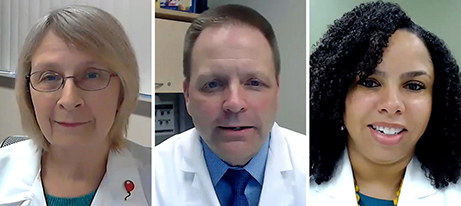
From left to right - Patricia Jones, Dennis Dietzen, Carolee D. Estelle
Lab medicine experts gave an insider’s view of what it takes to develop and deploy a laboratory-developed test (LDT) during a global crisis such as the COVID-19 pandemic. At an AACC-sponsored virtual congressional briefing, they discussed the regulatory requirements for these tests—and why it wouldn’t be prudent for the Food and Drug Administration (FDA) to further regulate LDTs. Such tests “are a critical part of the healthcare system’s COVID-19 toolbox,” said the briefing’s moderator, Patricia Jones, PhD, DABCC, FACB.
Certified labs stepped up to the plate to develop, validate, and perform LDTs for SARS-CoV-2 when commercial tests were scarce at the start of the pandemic, said Jones, medical director of laboratories at Children’s Medical Center in Dallas, professor of pathology at University of Texas Southwestern Medical Center, and chair of AACC’s Policy and External Affairs Core Committee. LDTs rapidly increased access to tests for patients, “much faster than would’ve been possible if healthcare institutes had waited for commercial COVID-19 tests to become available,” she added.
Dennis Dietzen, PhD, DABCC, FADLM, likens LDTs to a “scratch kitchen” of original materials. “You’re getting the skillet out, cutting up the raw ingredients, and getting ready for dinner. We do a lot of other tests in the lab that don’t involve scratch cooking,” said the medical director of laboratory services at St. Louis Children’s Hospital and professor of pathology and immunology and pediatrics at Washington University School of Medicine. LDTs are customized for smaller patient populations at a single geographic location. When a new disease such as COVID-19 evolves rapidly, labs attempt to learn more about the pathophysiology of the disease to build a test for a new marker or a technology to deploy, he explained.
“LDTs contribute to a diagnosis along with family history, social, and physical history,” he added.
The first SARS-CoV-2 tests developed by the U.S. Centers for Disease Control and Prevention (CDC) had some issues. Results took too long, making it difficult to identify carriers of infection, isolate them, and prevent further spread, said Dietzen. Contamination in CDC’s first kits also affected test results. “As this situation played out, laboratorians all over the country began to build and design their own LDTs for this infection. Those LDTs became the sole eyeballs that labs and public health officials had” in early spring when the scope of the problem became very clear, he emphasized.
Labs faced a host of roadblocks to building LDTs for the virus. “The supply lines were fragile—everyone wanted the same stuff, so we were all competing for the same reagents,” said Dietzen. Regulatory snafus posed challenges as well. FDA typically doesn’t have much jurisdiction over LDTs, but the agency asserted authority by declaring a public health emergency and requiring emergency use authorizations for tests that detect SARS-CoV-2. This complicated the way labs typically characterize tests, because they had to meet FDA’s stipulations, noted Dietzen.
His own campus produced not just one single LDT but several, with multiple sample modes. “We had multiple supply lines we had to take care of, and some of those were flushed with reagents and some were not.” Adaptations took place almost daily to ensure test capacity, as the pandemic escalated.
Carolee D. Estelle, MD, who helped lead the pandemic response at Parkland Health & Hospital System in Dallas, discussed the role of LDTs in improving the U.S. response to SARS-CoV-2.
When testing availability is low and turnaround time is long, it slows the ability to trace and isolate cases. “The ability to have testing that is quick and accurate allows us to make accurate diagnoses, isolate cases if necessary and optimize PPE, and create protocols that streamline operations,” said Estelle, interim chief of healthcare epidemiology at Parkland and assistant professor of medicine in the division of infectious diseases and geographic medicine at University of Texas Southwestern Medical Center.
“These principles apply to all communicable diseases that we manage today,” not just COVID-19, added Estelle.
The panel also discussed how additional regulations beyond those already in place by CLIA, the Centers for Medicare and Medicaid Services, and other bodies such as the College of American Pathologists would stymie future efforts to develop LDTs for COVID-19 and other diseases. “Over the last several years, FDA has tried to make the case that it should regulate laboratory-developed tests in addition to CMS,” said Jones, echoing longtime concerns by AACC.
“Thankfully, the Department of Health and Human Services recently declared that FDA does not have authority to regulate LDTs without formal notice-and-comment rulemaking, a decision that AACC has welcomed,” she added. Dietzen noted that “FDA regulation would be another layer of regulation that could be counterproductive with the current set of regulations we use.”
Bottom line: Without LDTs, patient care is not optimal nor personalized, he emphasized. “In the end, patients suffer unnecessarily without LDTs. This is the place where laboratorians thrive. … We know about the disease state, we know what clinicians need, and we know how to build these things. That’s where we innovate the best.”